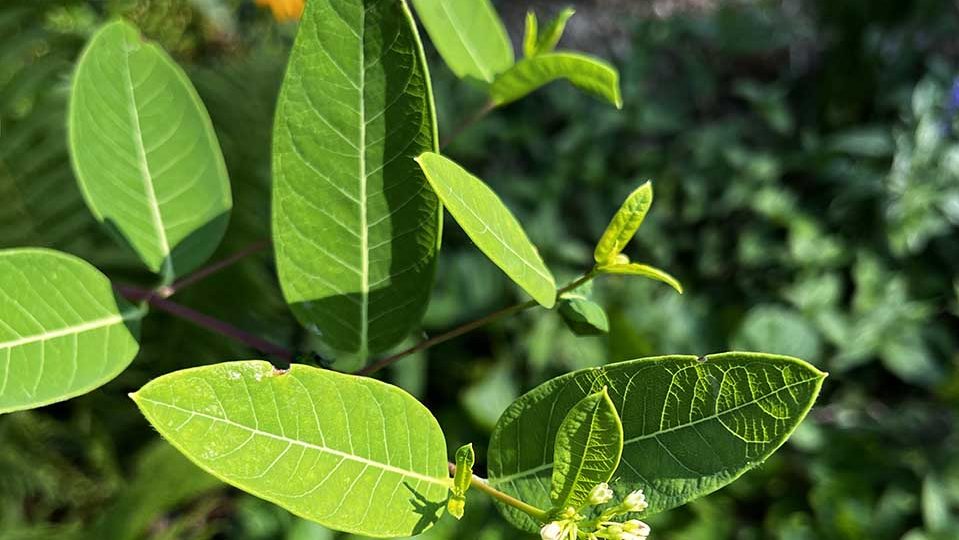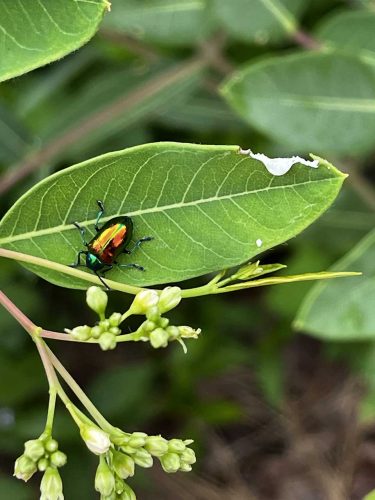Incandescent Insect
A beetle commonly known as dogbane—for its host plant, also known as dogbane—is admired for its incandescent colors.

 Our topic species is an insect and its host plant, namely a beetle with the scientific name Chrysochus auratus. The genus name, Chrysochus, derives from the Greek word chrysochóos, meaning “goldsmith,” and the species name, auratus, from the Latin word “gilded.” The common name is generally dogbane beetle because of its close association with apocynum, the dogbane plant. There are at least three species of dogbane but we will not discuss those distinctions.
Our topic species is an insect and its host plant, namely a beetle with the scientific name Chrysochus auratus. The genus name, Chrysochus, derives from the Greek word chrysochóos, meaning “goldsmith,” and the species name, auratus, from the Latin word “gilded.” The common name is generally dogbane beetle because of its close association with apocynum, the dogbane plant. There are at least three species of dogbane but we will not discuss those distinctions.
There are many supposedly common names associated with the plant species but I’ve never heard them used. They include American hemp, Amyroot, bitterroot, Canadian hemp, Indian hemp, Indian physic, and rheumatism weed. In my circles folks simply say “dogbane.”
The plant’s dapper little boarder gets a lot of attention. On walks in midsummer our CU hikers often show their appreciation with superlatives about its metallic shine. We hear, “Hey, look at this green beetle!” or “Wow, look how coppery this insect is!” Another observer declares, “What a lovely shade of blue!” and then gold or red are included in the descriptions that ensue.
In fact all are true. The beetle’s elytra (the forewings located on the second thoracic segment) have a dimpled surface covered in nanoscopic tilted plates that overlay a pigment layer. This produces an incandescence that changes when light bounces off the plates, depending on the angle of the viewer. The shine from its thin half-inch long body certainly gets a lot of admiration.
The beetle is made up of three segments—a head, thorax, and abdomen, with three sets of legs attached to the thorax. It has compound eyes and 11 antennal segments. The elytra are the split shell-like forewings that conceal a flight wing beneath. This characteristic is what defines most beetles.
You’ve likely seen a beetle seem to split its back open like a hatch, then display its wings and take to flight. To me it looks almost mechanical. The elytra are often colorfully decorated. The species you might be most familiar with is the firefly, which is actually a beetle. It opens its hardened wing cases forward—yes, elytra—and then the wings beneath are exposed, allowing it to fly off.
Like many insect species the dogbane beetle has evolved with its host plant in unique ways. Like some other insects it acquires the toxins that protect dogbane from being grazed upon by other animals. Dogbane contains highly poisonous compounds known as cardenolides; these are cardiac glycosides that can have deadly effects upon the heart if ingested.
However, the Chrysochus auratus eats the leaves without ill effects by storing the poisons in its glands. It then puts them to good use by spraying a would-be predator that encroaches on its personal space. Like a number of colorful things in nature it is thought that the bright color serves as a warning: “You don’t want to eat me!”

Dogbane is a close relative of milkweed; both have a sappy white liquid when the leaf is torn or bitten. The substance is sticky and even the well-designed mandible of the dogbane beetle can get gummed up. One mandible is longer than the other, and grooved so they can close tightly together. To keep from getting glued shut the beetle backs up, sliding off the mess by using the leaf as a napkin of sorts. One entomologist described it as similar to dragging a bubble-gummed shoe backward on the pavement to clean it off.
The lifecycle goes something like this: Two beetles mate each day for up to an hour. In this species the male chooses the female, evidently unusual for most beetles. Most of the time the process involves the male guarding his date, not making hanky-panky but rather preventing other would-be suitors from mating with her.
When the female lays her eggs she defecates on a dogbane leaf and places the ova on her feces. When the worm-like larvae hatch they burrow into the ground and attach to the plant’s roots. In mid-summer the beetles emerge as adults and live for about two months.
Many articles and videos get very strident about the toxicity of its host, dogbane, and the subsequent dangerous nature of the beetle. It’s hard for me to get worked up about this since eating beetles or dogbane is not on my agenda. But should you have a child, or the propensity for this kind of fare yourself, I would call upon a New Yorker/Philadelphian piece of advice: “Fuhgeddaboutdit!” It’s poisonous.
Cattle have been killed by eating dogbane but luckily the nasty taste discourages most browsers from consuming a lethal dose. The U.S. Department of Agriculture lists these signs of dogbane poisoning—“rapid pulse, dilation of pupils, vomiting, blue coloration of mucous membranes, progressive body weakness, convulsions, coma, mild myocardial degeneration, or death.”
I don’t know about you, but they had me discouraged at “rapid pulse.”
Is it poisonous to dogs? Yes, but so are English ivy, grapes, and other flora. If your dog or child is a grazer you would be best advised to get rid of this plant. But to be clear, accidental poisoning is unlikely because of the bitter taste.
Are dogbane beetles a pest for crops or do they have any economic impacts? No. They eat exclusively dogbane or milkweed.
Many plants with toxic qualities have been gathered for medicinal purposes. Dogbane has been used to reduce fluids collecting in the body after heart failure-edema/dropsy. It was listed in the U.S. Pharmacopeia in 1831-1916 and National Formulary in 1916-1960. It has also been employed in rheumatism medicine and in the treatment of wounds. Although it has been applied in the treatment of heart failure, even small doses are dangerous.
Native Americans took advantage of all the species of dogbane. One common name, Indian hemp, comes from the plant’s use by Native Americans to make fiber; they wove it into twine for fishing line, baskets, ropes, fabrics, and mats.
Medical purposes deriving from both leaves and roots abound—a cough preparation, a laxative, an antidiarrheal, a purgative, a diuretic, as well as its use in wound care, kidney ailments, cramps, contraception, and many more. But remember, Native Americans went to shamans for healthcare. Dogbane’s use in herbal remedies or misuse can cause poisoning. If you are ill, go to your doctor for treatments.
I thought that our modern-day child’s play could be risky until I read that Havasupai tribal youngsters played a game that involved rubbing the milky sap from dogbane on playmates’ eyelids in order to seal them shut. Why does this not sound like fun to me?
Allow me to turn to entomologist Douglas Tallamy’s description of beetles in his book, Bringing Nature Home: “There are well over 300,000 species of beetles described by taxonomists. There remain many unnamed species. There are 6 times as many described beetles as there are all vertebrates combined, 34 times more beetle species than bird species. In fact, 30 percent of all animals are beetles (paraphrased).”
Tallamy suggests that the reason beetles are so numerous is because they are very good at eating plants. Chrysomelidae, known as leaf beetles, are one of the largest insect families, with about 35,000 species worldwide and 1,700 of those in North America.
So with all these beetles to choose from, why choose the dogbane leaf beetle? Because at this time of year, if you find dogbane, you are likely to find the dogbane beetle. And you are likely to notice the insect because it is wildly brilliant and worthy of admiration. We have not even scratched the surface of all that is known about this insect, let alone all that is yet to be discovered. But that doesn’t prevent us from marveling at its beauty. n
Sources:
- “One Gorgeous Beetle: Dogbane Leaf Beetle, Chrysochus Auratus, “Micheal Raupp, July 2016.
- Weber, S. and Seaman, D. Havasupai Habitat: A. F. Whitings’ Ethnography of a Traditional Indian Culture, Tucson: University of Arizona Press, 1985. Pg. 236.
- Animal Diversity Website, University of Michigan, Museum of Zoology, Chrysochus Auratus
- Chris Egnoto, Dogbane leaf beetle can stop your heart, 2019 video
- Bringing Nature Home, Douglas W. Tallamy
- https://www.ars.usda.gov/pacific-west-area/logan-ut/poisonous-plant-research/docs/hemp-dogbane-apocynum-cannabinum/
- University of Wisconsin, Milwaukee Field Station, Dogbane Leaf Beetle, August 2010.









